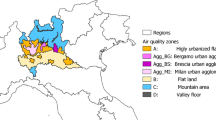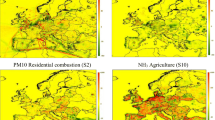Abstract
Air quality management takes into consideration emission factors and inventories which are essential for developing emission control strategies for determining applicability of permitting and controlling programs and ascertaining the effects of sources and appropriate mitigation strategies. Emission estimates are also important for the related applications such as climate change etc. Emission inventories are studied by emission factors, which mostly lack association of some parameters, such as regional meteorological conditions, socioeconomic and developmental status and industrialization. This study offers a new approach (estimation of imission load) for the calculation of emission inventories after adding the estimation of many possible inputs and outputs. Foremost, average areal concentrations of pollutants are calculated by applying Percentage Weighting Polygon Method (PWP) to Erzurum urban SO2 imission measurement values. Later, mixing height of the study region in Erzurum, Turkey, is assessed by upper atmosphere observations from March 31st to April 1st 2006. Imission load of SO2 in Erzurum urban centre are calculated by a different paradigm based on multiplying urban centre area, mixing height and areal pollutant SO2 concentration values.
Similar content being viewed by others
References
Ahlvik, P., Eggleston, E., Gorissen, N., Hassel, D., Hickman, A.-J., Joumard, R., Ntziachristos, L., Rijkeboer, R., Samaras, Z., and Zierock, K.-H. (1997). COPERT II computer programme to calculate emissions from road transport, methodology and emission factors, 2nd Edition, European Environmental Agency, European Topic Center on Air Emissions.
Balestrini, R., Gali, L., and Tartari, G. (2000). “Wet and dry atmospheric deposition at prealpine and alpine sites in Northern Italy.” Atmospheric Environment, Vol. 34, No. 9, pp. 1455–1470.
Bayraktar, H. and Turalıoğlu, F. S. (2005). “Average areal sulphur dioxide concentration estimation by percentage weighting polygon method in Erzurum urban centre, Turkey.” Atmospheric Environment, Vol. 39, No. 32, pp. 5991–5999.
Beyrich, F. (1997). “Mixing height estimation from sodar data-a critical discussion.” Atmospheric Environment, Vol. 31, No. 23, pp. 3941–3953.
Bhanarkar, A. D., Rao, P. S., Gajghate, D. G., and Nema, P. (2005). “Inventory of SO2, PM and toxic metals emissions from industrial sources in Greater Mumbai, India.” Atmopsheric Environment, Vol. 39, No. 21, pp. 3851–3864.
CITEPA (Centre Interprofessional Technique de la Pollution Atmospherique) (1992). Corinair inventory-default emission factors handbook, 2nd Edition, CEC-DGXI, Paris.
Elbir, T. and Muezzinoğlu, A. (2004). “Estimation of emission strengths of primary air pollutants in the city of Izmir, Turkey.” Atmospheric Environment, Vol. 38, No. 13, pp. 1851–1857.
Elbir, T., Müezzinoğlu, A., and Bayram, A. (2000). “Evaluation of some air pollution indicators in Turkey.” Environment International, Vol. 26, Nos. 1–2, pp. 5–10.
EMEP Taskforce on Emissions Inventories (1996). Atmospheric emission inventory guidebook, 1st Edition, European Environmental Agency, Copenhagen, Denmark.
Grosjean, E., Grosjean, D., Fraser, M. P., and Cass, G. R. (1996). “Air quality model evaluation data for organics. 2. C1-C14 Carbonyls in Los Angeles Air.” Environ. Sci. Technol., Vol. 30, No. 9, pp. 2687–2703.
IPCC (2000). Good practice guidance and uncertainty management in national greenhouse gas inventories, Hayama, Kanagawa, Japan7 IPCC National Greenhouse Gas Inventories Programme, Technical Support Unit.
Koch, G. S. and Link, R. E. (1971). Statistical analysis of geological data, Vols I and II, Dower Publications, Inc., New York, N.Y.
Koop, G. and Tole, L. (2004). “Measuring the health effects of air pollution: To what extent can we really say that people are dying from bad air?” Journal of Environmental Economics and Management, Vol. 47, No. 1, pp. 30–54.
Nath, S. and Patil, R. S. (2006). “Prediction of air pollution concentration using an in situ real time mixing height model.” Atmospheric Environment, Vol. 40, No. 20, pp. 3816–3822.
Ntziachristos, L. and Samaras, Z. (2000). COPERT III, computer program to calculate emission from road transport, methodology and emission factors, Version 2.1, European Environment Agency.
Pacyna, E. G., Pacyna, J. M., Steenhuisen, F., and Wilson, S. (2006). “Global anthropogenic mercury emission inventory for 2000.” Atmospheric Environment, Vol. 40, No. 22, pp. 4048–4063.
Rabl, A. (1999). “Air pollution and buildings: An estimation of damage costs in France.” Environ. Impact Assess. Rev., Vol. 19, No. 6, pp. 361–385.
Roeckner, E., Stier, P., Feichter, J., Kloster, S., Esch, M., and Fischer-Bruns, I. (2006). “Impact of carbonaceous aerosol emissions on regional climate change.” Climate Dynamics, Vol. 27, Nos. 7–8, pp. 553–571.
Romano, D., Bernetti, A., and De Lauretis, R. (2004). “Different methodologies to quantify uncertainties of air emissions.” Environment International, Vol. 30, No. 8, pp. 1099–1107.
Seibert, P., Beyrich, F., Gryning, S-E., Joffre, S., Rasmussen, A., and Tercier, P. (2000). “Review and intercomparison of operational methods for the determination of the mixing height.” Atmospheric Environment, Vol. 34, No. 7, pp. 1001–1027.
Sen, Z. (1998). “Average areal precipitation by percentage weighting polygon method.” Journal of Hydrologic Engineering, Vol. 1, Nos. 1–2, pp. 69–72.
Shevchenko, V., Lisitzin, A., Vinogradova, A., and Stein, R. (2003). “Heavy metals in aerosols over the seas of the Russian Arctic.” The Science of the Total Environment, Vol. 306, Nos. 1–3, pp. 11–25.
Smith, S. J., Pitcher, H., and Wigley, T. M. L. (2001). “Global and regional anthropogenic sulfur dioxide emissions.” Global and Planetary Change, Vol. 29, Nos. 1–2, pp. 99–119.
Sturm, P. J., Sudy, C., Almbauer, R. A., and Meinhart, J. (1999). “Updated urban emission inventory with a high resolution in time and space fort he city of Graz.” The Science of the Total Environment, Vol. 235, Nos. 1–3, pp. 111–118.
Topçu, N., Keskinler, B., Bayramoğlu, M., and Akçay, M. (1993). “Air pollution modelling in Erzurum city.” Environmental Pollution, Vol. 79, No. 1, pp. 9–13.
URBAIR, (1997). In: Shah Jitendra, J., Nagpal, T. (Eds.), Urban air quality management in asia, Greater Mumbai Report, World Bank Technical Paper No. 381, Washington, DC.
USEPA, (2003). Air CHIEF ver. 10. Emission factor and inventory group, CD-ROM of Clearing House for Inventories and emission Factor (CHIEF), EPA454/C-03-001 Version 10.
Vallack, H. W., Cinderby, S., Kuylenstierna, J. C. I., and Heaps, C. (2001). “Emission inventories for SO2 and NOx in developing country regions in 1995 with projected emissions for 2025 according to two scenarios.” Water, Air, and Soil Pollution, Vol. 130, Nos. 1–4, pp. 217–222.
Winiwarter, W. and Schimak, G. (2005). “Environmental software systems for emission inventories.” Environmental Modelling & Software, Vol. 20, pp. No. 12, 1469–1477.
Zaim, K. K. (1999). “Modified GDP through health cost analysis of air pollution: The case of Turkey.” Environmental Management, Vol. 23, No. 2, pp. 271–277.
Author information
Authors and Affiliations
Corresponding author
Rights and permissions
About this article
Cite this article
Bayraktar, H. A new approach for the estimation of immission loads under steady state conditions. KSCE J Civ Eng 14, 823–827 (2010). https://doi.org/10.1007/s12205-011-0119-y
Received:
Revised:
Accepted:
Published:
Issue Date:
DOI: https://doi.org/10.1007/s12205-011-0119-y




